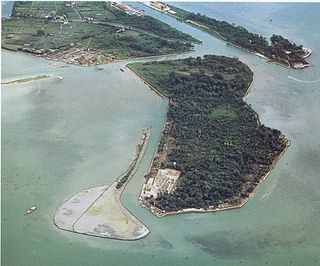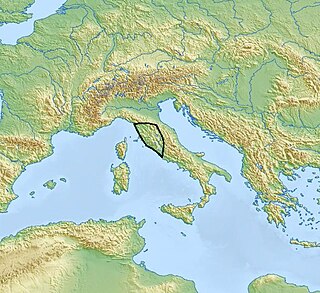
Ladin is a Romance language of the Rhaeto-Romance subgroup, mainly spoken in the Dolomite Mountains in Northern Italy in the provinces of South Tyrol, Trentino, and Belluno, by the Ladin people. It exhibits similarities to Romansh, spoken in Switzerland, as well as Friulian, spoken in north-east Italy.

Tiziano Vecelli or Vecellio, Latinized as Titianus, hence known in English as Titian, was an Italian Renaissance painter, the most important artist of Renaissance Venetian painting. He was born in Pieve di Cadore, near Belluno. During his lifetime he was often called da Cadore, 'from Cadore', taken from his native region.

The Patriarchal Cathedral Basilica of Saint Mark, commonly known as St Mark's Basilica, is the cathedral church of the Patriarchate of Venice; it became the episcopal seat of the Patriarch of Venice in 1807, replacing the earlier cathedral of San Pietro di Castello. It is dedicated to and holds the relics of Saint Mark the Evangelist, the patron saint of the city.

Cadore is a historical region in the Italian region of Veneto, in the northernmost part of the province of Belluno bordering on Austria, the Trentino-Alto Adige/Südtirol and Friuli-Venezia Giulia. It is watered by the Piave River which has its source in the Carnic Alps. Once an undeveloped and poor district, the former contado (countship) of Cadore now has a thriving economy based on tourism and a small manufacturing industry, specialising in the production of glasses.

Francesco Vecellio was a Venetian painter of the Italian Renaissance. He was the elder brother and close collaborator of the painter Tiziano Vecellio ("Titian").

The da Camino were an Italian noble family whose fame is connected to the mediaeval history of the March of Treviso, a city of which they were lords for a while.

La Certosa is an island in the Venetian Lagoon, northern Italy. It is located northeast of Venice, fewer than 250 metres from San Pietro di Castello and little more than 500 metres from the Venice Lido. A 20-metre-wide (66 ft) channel separates it from the Vignole island. La Certosa has a surface of some 22 hectares.

The Castellieri culture developed in Istria during the Early and Middle Bronze Age, and later expanded into Friuli, Dalmatia and the neighbouring areas. It lasted for more than a millennium, from the 18th century BC until the Roman conquest in the 3rd century BC. It takes its name from the fortified settlements, Castellieri, which characterized the culture. The term was coined by Carlo Marchesetti.
Sergio Zanni is an Italian painter and sculptor. After obtaining the Diploma at the Institute of Arts 'Dosso Dossi' in Ferrara, Italy, he graduated from the Academy of Arts in Bologna. He taught in the Institute of Arts 'Dosso Dossi' until 1995. For his research in sculpturing he utilized backed clay and, successively, lighter material for sculptures of large dimensions.

Cadorino, a dialect of Ladin, is the language of Cadore, at the feet of the Dolomites in the province of Belluno. It is distinct from neighboring dialects, and though it has received relatively little attention, it is important to an understanding of the linguistic history of northern Italy.

Ivo Mattozzi, is a professor at the University of Bologna. He teaches methodology and teaching of history. He has given lectures in Italy, Spain, Brazil and Argentina and was the president of the history association, "Clio '92". His articles and publications have been translated into Spanish, Portuguese and Greek.

The Rinaldone culture was an Eneolithic culture that spread between the 4th and the 3rd millennium BC in northern and central Lazio, in southern Tuscany and, to a lesser extent, also in Marche and Umbria. It takes its name from the town of Rinaldone, near Montefiascone in the province of Viterbo, northern Lazio.
Francesco da Milano was an Italian painter from Lombardy. He was active between 1502 and 1548 and twenty of his works in oil-on-canvas and fresco survive in the hill-country of Treviso and Friuli, including a fresco cycle at Castello Roganzuolo. As a Lombard, some aspects of his style were influenced by Bernardo Zenale and Vincenzo Civerchio, though he was also influenced by Titian, who like him lived and worked in the "contrada de Piai" in Serravalle. Titian was preferred to Francesco by Serravalle's town council - Francesco had been the initial choice to paint the Serravalle Altarpiece.

The Serravalle Altarpiece or Madonna and Child in Glory with Saint Andrew and Saint Peter is a painting by Titian, now in the church of Santa Maria Nova in Serravalle, for which it was commissioned.

The Castello Roganzuolo Altarpiece, Castello Roganzuolo Polyptych or Madonna and Child with Saint Peter and Saint Paul is a painting by Titian, commissioned in 1543 by the leading citizens of Castello Roganzuolo, Province of Treviso, Veneto, Italy. It is now in the Albino Luciani Diocesan Museum in Vittorio Veneto.

The Scuola del Santo or Scoletta was the headquarters of the Archconfraternity of St Anthony of Padua. It overhangs the churchyard of Basilica of Saint Anthony of Padua, next door to the St. George's Oratory.
The Palazzo Crepadona is a medieval palace, presently used as a cultural center including a civic library and display halls in the historic center of Belluno, region of Veneto, Italy.

Minerva between Geometry and Arithmetic is a 1550 fresco fragment, usually attributed to Paolo Veronese but by some art historians to Anselmo Canera or Giambattista Zelotti. It was painted for the Palazzo de Soranzi in Castelfranco Veneto but now in the Palazzo Balbi in Venice.

Col Visentin is a mountain in the Bellunes Alps, in the Veneto region of Italy, which marks a geographical border point between the province of Belluno and the province of Treviso.















